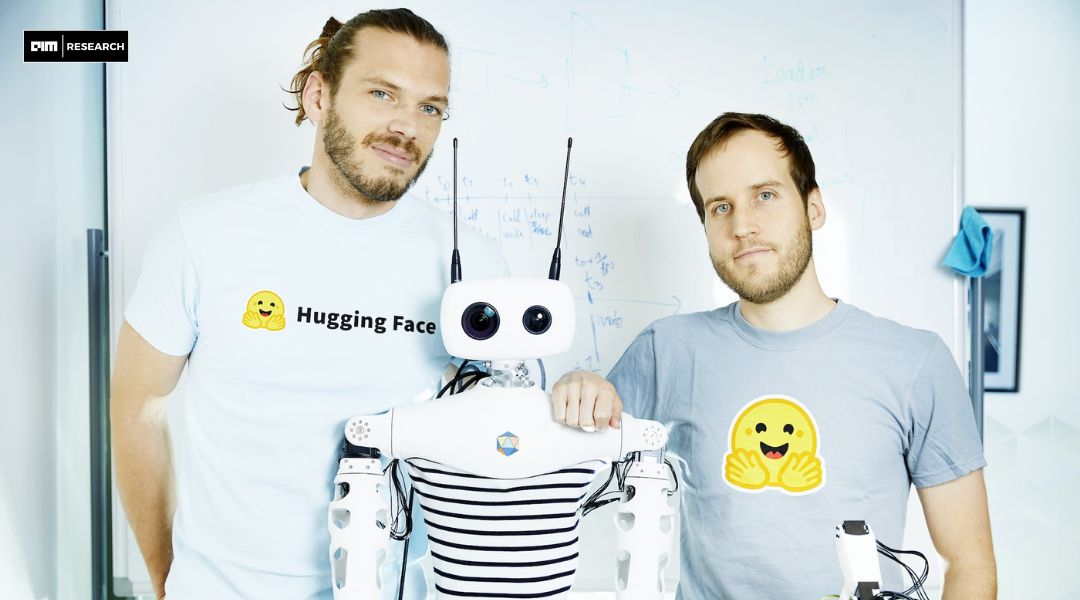

In 2024, Hugging Face launched its robotics initiative LeRobot, led by former Tesla robotics lead Remi Cadene. One year later, the GitHub repository for LeRobot has accumulated more than 12,000 stars, and a thriving DIY community has emerged on platforms like YouTube and Discord. Hugging Face has now taken the next step in its open-source robotics journey by acquiring Pollen Robotics, a French startup best known for building the humanoid robot Reachy 2.
Founded nearly a decade ago, Pollen Robotics has spent years developing open-source robots and hardware. Co-founder Matthieu Lapeyre described Hugging Face as a “natural home” for their mission, citing shared values around openness and accessibility. “From the start, we built Pollen Robotics with open source at its core, driven by our belief that robots will play a profound role in our lives serving as the interface between AI and the physical world,” Lapeyre said.
The acquisition brings Pollen’s team of around 20 employees into Hugging Face, including co-founders Lapeyre and Pierre Rouanet. According to a company spokesperson, this makes it Hugging Face’s largest acquisition by headcount. It is also the company’s fifth overall acquisition, following previous additions like Gradio and XetHub.
Hugging Face plans to sell Reachy 2, a bug-eyed, two-armed humanoid robot that is already in use at institutions such as Cornell and Carnegie Mellon. Designed for research, education, and embodied AI experiments, Reachy 2 is VR-compatible and fully open source.
More than just a product launch, Hugging Face sees Reachy 2 as part of a broader shift toward physical AI. Co-founder and chief scientist Thomas Wolf explained the company’s philosophy: “We believe robotics could be the next frontier unlocked by AI — and it should be open, affordable, and private.” He added that the goal is to allow everyone from hobbyists to enterprises to build or use robotic assistants based on open solutions, rather than relying on closed, remote-controlled hardware.
CEO Clément Delangue emphasized the importance of transparency in robotics, especially as the industry begins to move into homes and workplaces. “It’s really important for robotics to be as open source as possible,” he said. “When you think about physical objects doing physical things at work and at home, the level of trust and transparency I need is much higher than for something I chat with on my laptop.”
Pollen Robotics has released videos of Reachy 2 performing tasks like picking up fruit and tidying mugs. Lapeyre confirmed that multiple AI companies are using the robot to explore robotic manipulation, although he declined to name them due to confidentiality agreements. While he acknowledged that the commercial viability of humanoid robots remains uncertain due to reliability and unclear use cases, he noted that some companies including Tesla, Figure, and Agility Robotics are beginning to make progress.
Hugging Face’s open-source vision spans across AI and robotics. The company already hosts several robotics-related models and codebases, and their usage has grown sharply over the past year. Wolf stated that the next phase of 2025 includes robotics, chatbots, agents, and robots. He also pointed to growing concerns around surveillance, noting, “Now cameras can spy on everybody.” He argued that open source can be much better for security and cited a recent security flaw in Unitree’s robot dog as an example of the risks with closed systems.
Wolf said safety is not just a technical concern but a community one. “You can’t cheat; you can’t hide with open source,” he said. The Hugging Face community, already known for writing and sharing high-quality machine learning code, is now beginning to contribute to robotics code capable of controlling real-world machines.
The company’s framework centers on three pillars: open-source models, open-source datasets, and open-source hardware. They’ve also seen demand from developers, with thousands of people building robotic arms using Hugging Face’s latest tutorial.
With the announcement of our acquisition of @pollenrobotics, many people have been asking me what is "open-source AI robotics"?
— clem 🤗 (@ClementDelangue) April 14, 2025
In my opinion, it's a mix of:
– Open-source models (https://t.co/0FH87Ur89o + @LeRobotHF + others)
– Open-source datasets (https://t.co/1ugJSuKdpZ)
-… pic.twitter.com/NIWf7tA7lg
Sergey Levine, assistant professor at UC Berkeley and co-founder of robotics startup Physical Intelligence, said open access increases the pace of advancement. Physical Intelligence released its first robot foundation model, Pi0, on Hugging Face in February. The model is designed to enable various robots to perform physical tasks, and both academia and industry have begun contributing improvements.
The shift toward open-weight models has been visible across the AI ecosystem. Meta released Llama, DeepSeek launched a competitive model at lower cost, and OpenAI plans to release a free, open-weight model this summer.
Last month, NVIDIA selected Hugging Face as its preferred platform to host GR00T N1, its open-source AI model for humanoid robots.
Hugging Face is currently selling Reachy 2 for $70,000 and plans to lower the cost over time. The company is also considering open-sourcing the full hardware design, including 3D printable parts.
“At Hugging Face—in robotics and across all AI fields—we believe in a future where AI and robots are open-source, transparent, and affordable; community-built and safe; hackable and fun.” said Thomas Wolf.
If you've followed the progress of robotics in the past 18 months, you've likely noticed how robotics is increasingly becoming the next frontier that AI will unlock.
— Thomas Wolf (@Thom_Wolf) April 14, 2025
At Hugging Face—in robotics and across all AI fields—we believe in a future where AI and robots are open-source,…
📣 Want to advertise in AIM Research? Book here >
Cypher 2024
21-22 Nov 2024, Santa Clara Convention Center, CA
A Vendor Briefing is a research tool for our industry analysts, and an opportunity for a vendor to present its products, services and business strategies to analysts who cover the vendor specifically or a related technology or market.
AIM Research encourages technology vendors and agencies to brief our team for PeMa Quadrants, when introducing a new product, changing a business model, or forming a partnership, merger, or acquisition.


